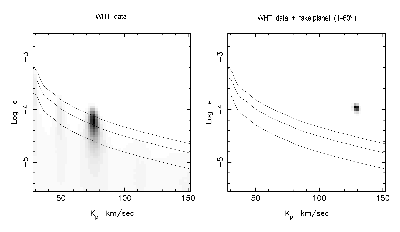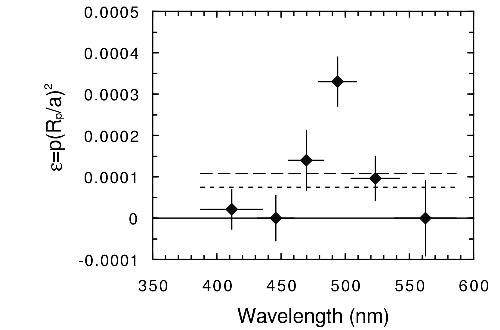- Butler, R. P., Marcy, G. W., Williams, E., Hauser, H., Shirts, P., 1997, ApJ, 474, L115. Citation in article | ADS
- Charbonneau, D., Noyes, R. W., Korzennik, S., Nisenson, P., Jha, S., Vogt, S. S., Kibrick, R. I., 1999, ApJ, 522, L145. Citation in article | ADS
- Collier-Cameron, A., Horne, K. D., Penny, A. J., James, D. J., 1999, Nature, 402, 751. Citation in article | ADS
- Donati, J. -F., Semel, M., Carter, B., Rees, D. E., Collier-Cameron, A., 1997, MNRAS, 291, 658. Citation in article | ADS
- Marley, M. S., Gelino, C., Stephens, D., Lunine, J. I., Freedman, R., Sharp, C., 1999, ApJ, 513, 879. Citation in article | ADS
- Mayor, M., Queloz, D., 1995, Nature, 378, 355. Citation in article | ADS
- Sudarsky, D., Burrows, A., Pinto, P., 1999, astro-ph/9910504. Citation in article | ADS
| THE ING NEWSLETTER | No. 2, March 2000 |
|
|
SCIENCE |
|
|
|
| Previous: | Contacts at ING | Up: | Table of Contents | Next: | Gamma-Ray Burst Afterglows: Suprises from the Sky |
Other available formats: PDF | gzipped Postscript
WHT Achieves First Direct Detection of an Extra-solar Planet
Andrew Collier-Cameron1, Keith Horne1, Alan Penny2, David James1
1: School
of Physics and Astronomy, University of St Andrews; 2:
Rutherford Appleton Laboratory
The last few years have seen huge advances in the quest to discover and characterise planetary systems orbiting stars other than the Sun. During the 1980s, infrared and mm-wave observations revealed a high incidence of solar system-sized dusty discs around T Tauri stars and young main-sequence stars. These both confirmed that our own planetary system originated in a flattened, rotating disc of dust and gas, and suggested that planetary systems should be commonplace around other solar-type stars. The expectation was that our own system would turn out to be fairly typical. Small rocky planets should condense from refractory dust grains in the warm inner disc. Giant planets, with cores of a few Earth masses composed of dust grains with ice mantles, could sweep up the large amounts of gas available in the outer parts of the disc.
The discovery by Mayor & Queloz (1995) of a Jupiter-mass planet (msini=0.45MJ) in a 4.2-day orbit about the star 51 Peg thus came as a surprise. In the four years since then, the tally has grown to some 30 planetary candidates detected from the orbital "Doppler wobbles" of their parent stars. Even though this method has a selection bias toward high-mass planets in short-period orbits, the existence of close-orbiting giant planets and longer-period objects in highly eccentric orbits is surprising. Planetary-system formation is increasingly looking like a violent business, with dynamical interactions between discs and planets producing inward orbital migration, destabilisation of orbits and possibly ejection of planets into interstellar space.
Aside from the dynamical considerations, these discoveries provide exciting new challenges for models of the interior and atmospheric properties of giant planets at a variety of distances from their parent stars. Are they like the methane brown dwarfs, with extensive sodium and methane absorption (Sudarsky et al., 1999) at optical and IR wavelengths? Do they possess cloud decks of silicates and iron condensates (Marley et al., 1999), and if so, what optical properties would be expected of such clouds?
The idea of attempting a direct detection grew out of work one of us (ACC) has been conducting in collaboration with Jean-Francois Donati (Toulouse) on Zeeman-Doppler imaging of magnetic polarity patterns on stellar surfaces. This entails precise registration and subtraction of left-and right-circularly polarized echelle spectra, and the use of least-squares deconvolution (Donati et al., 1997) to combine Stokes V profile information from the thousands of absorption-line profiles recorded in each echellogram. The method yields composite profiles of Stokes V signatures hundreds or thousands of times fainter than the direct spectrum, with signal-to-noise ratios several tens of times greater than the best-exposed parts of each echellogram. We expect the reflected-light signature of a close-orbiting giant planet to contain the same set of lines as its parent star, but to be 10,000 to 30,000 times fainter than the direct starlight and Doppler shifted by orbital motion. We found that it should be possible to isolate the moving planet signature, provided we could first subtract an accurate model of the direct starlight from the data.
We selected tau Boo (Butler et al., 1997) as our first target. Being closer to its star than any of the other known "Hot Jupiters", the giant planet orbiting tau Boo should intercept more starlight, and hence appear brighter in relation to its star, than any of the other known planets of its class. We secured our first 4 clear nights' observations in 1998 April. We initially tried to model the direct starlight using spectra of the star taken near inferior conjunction, when the planet's dark side is turned toward us. This proved unsatisfactory: small night-to-night shifts in the position of the spectrum on the detector conspired with low-level fixed-pattern noise that could not be flat-fielded out, to give non-Gaussian noise levels greatly in excess of photon statistics. Within any given night, however, the position of the spectrum on the detector remained essentially unchanged. By constructing the template spectrum from the sum of all spectra taken on a given night, the fixed-pattern noise level was reduced to 10 – 20% of the photon noise. The penalty for this is that, on nights when the planet is near quadrature and the velocity is almost constant, the planet signature gets subtracted out along with the starlight. Accordingly, the best times to observe the planet are just before and just after superior conjunction. The planet is then at its brightest, its lines are Doppler shifted well clear of the star's lines, and its velocity is changing rapidly. These considerations dictated our observing strategy in the 1999 season, when all observations were scheduled close to superior conjunction. To maximize the photon catch on each CCD exposure, we nodded the telescope to widen the spatial profile of the spectrum on the detector. This also allowed us to expose for longer without saturating the CCD.
By the end of the 1999 season
we had amassed a total of nearly 600 spectra in 9 clear nights of observation.
The S:N ratios of the deconvolved profiles were typically around 20,000,
easily sufficient to detect a planet of Jovian dimensions and reflectivity
if seen fully illuminated. This allowed us to place strong upper limits
ruling out a Jupiter-like planet in near-edge-on orbits — and produced
evidence for detection of a planet at an orbital inclination of 29°
(Figure 1). A detailed investigation suggests a false-alarm probability
of about 5% (Collier-Cameron
et al., 1999).
 |
| Figure 1. The relative probability map testing for the presence of a planetary reflected-light signature. For each possible value of the unknown planet-to-star brightness ratio epsilon, and of the planet's projected orbit velocity Kp, darker shades denote progressively better fits to the data. The solid curves show the 68.3%, 95.4%, and 99.7% upper limits above which a planet signature can be ruled out as a function of Kp. The plot shows significant evidence for a planet at projected orbital velocity Kp=74±3 kms-1 and face-on planet-to-star flux ratio epsilon=7.5±3×10-5. Since the true orbital velocity amplitude is close to 152 kms-1, the implied orbital inclination is close to 29°. In the right-hand panel, the signature of a simulated planet with Jupiter-like reflectivity, radius 1.4 times Jupiter, and orbital inclination 60° is detected at a high level of significance. [ GIF | TIFF ] |
We were able to construct a crude
albedo spectrum for the planet, by measuring the strength of the planet
signature in 6 independent subsets of the data spanning different wavelength
ranges between 3850 and 6100 Å. This "spectrum" is shown in Figure
2. Curiously, the signal is only significant at wavelengths between about
4600 and 5000 Å, suggesting that strong absorption features may be
present. The strength of the detection in the 4600 to 5000 Å region
suggests a radius nearly twice that of Jupiter for plausible albedo values,
and the inclination yields a mass 8 times that of Jupiter.
 |
| Figure 2. The wavelength dependence of the planet-to-star brightness ratio epsilon (lambda) at zero phase angle for tau Boo b, derived from six independent subsets of the echelle data. Signals are present between 4600 and 5000 Å but absent at other wavelengths. [ TIFF ] |
At face value, our candidate detection
appears to conflict with the upper limits from 3 nights of Keck data published
by Charbonneau
et al. (1999), who failed to see the planet at a signal level apparently
half that of our claimed detection. Part of the discrepancy results from
differences in the models used by the two teams to represent the angular
dependence of the planet's reflectivity. We also understand that they did
not compensate fully for the fact that some of the planet signal goes missing
when you subtract out the direct light from the star. This is particularly
important for a tilted orbit. Together these differences between the two
analyses bring the results into agreement within their
uncertainties.
We will seek confirmation of this detection using the WHT in the spring of 2000, this time targeting a set of orbital phases optimized for an orbital inclination near 30°. The new phasing will allow us to gather up to 16 times as many "useful" photons from the planet, as we've amassed so far. If the detection survives this more intense scrutiny, we should be able to quadruple the spectral resolution and double the S:N relative to the existing data, giving us a better chance of identifying the major optical absorbing species.
References:
Email contact: Andrew Collier-Cameron (acc4@st-andrews.ac.uk)
| Previous: | Contacts at ING | Up: | Table of Contents | Next: | Gamma-Ray Burst Afterglows: Suprises from the Sky |
| GENERAL | SCIENCE | TELESCOPES AND INSTRUMENTATION | OTHER NEWS FROM ING | TELESCOPE TIME |